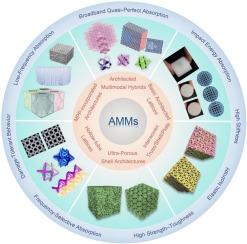Emerging acousto-mechanical metamaterials: From physics-guided design to coupling-driven performance
IF 22
1区 材料科学
Q1 MATERIALS SCIENCE, MULTIDISCIPLINARY
引用次数: 0
Abstract
The growing demand for materials that simultaneously absorb airborne sound and sustain mechanical loads has catalyzed the rise of acousto-mechanical metamaterials (AMMs)—architected systems that embed acoustic resonances within mechanically efficient architectures, enabling multifunctionality beyond the reach of conventional materials. This review provides in-depth insights into the structural and physical principles that govern acoustic absorption—the central challenge in advancing AMMs. We classify existing architectures and reveal how tailored topologies can achieve superior resonant responses and dissipative pathways. To overcome causality-governed efficiency–thickness trade-offs, we consolidate three physics-informed enhancement strategies: coherent weak resonator coupling, geometry-driven impedance tuning, and intrinsic loss engineering—offering viable paths toward optimal absorption. Critically, we elucidate the structural origins of acousto-mechanical coupling by analyzing synergistic trends and mismatches arising from parent material, unit-cell scale, and topological interdependence. We introduce a three-tier coupling framework based on geometry-sharing levels, clarifying when acoustic and mechanical functions can be decoupled and when they demand co-optimization. Finally, we outline key challenges and propose future directions in functional integration, AI-driven development, and real-world deployment. Positioned at the intersection of geometry, physics, and multifunctionality, AMMs are poised to serve as a versatile platform for next-generation engineered systems.

新兴声-机械超材料:从物理导向设计到耦合驱动性能
对同时吸收空气中声音和承受机械负荷的材料的需求不断增长,促进了声-机械超材料(amm)架构系统的兴起,这种系统将声学共振嵌入到机械高效的架构中,实现了传统材料无法实现的多功能。这篇综述提供了对控制声吸收的结构和物理原理的深入见解,这是推进amm的核心挑战。我们对现有架构进行了分类,并揭示了定制拓扑如何实现卓越的谐振响应和耗散路径。为了克服因果关系控制的效率-厚度权衡,我们整合了三种物理增强策略:相干弱谐振腔耦合、几何驱动的阻抗调谐和本征损耗工程,为实现最佳吸收提供了可行的途径。重要的是,我们通过分析由母体材料、单元胞尺度和拓扑相互依赖引起的协同趋势和不匹配来阐明声-力学耦合的结构起源。我们引入了一个基于几何共享级别的三层耦合框架,明确了声学和机械功能何时可以解耦以及何时需要共同优化。最后,我们概述了关键挑战,并提出了功能集成、人工智能驱动开发和现实世界部署的未来方向。定位于几何、物理和多功能的交叉点,amm准备作为下一代工程系统的通用平台。
本文章由计算机程序翻译,如有差异,请以英文原文为准。
求助全文
约1分钟内获得全文
求助全文
来源期刊

Materials Today
工程技术-材料科学:综合
CiteScore
36.30
自引率
1.20%
发文量
237
审稿时长
23 days
期刊介绍:
Materials Today is the leading journal in the Materials Today family, focusing on the latest and most impactful work in the materials science community. With a reputation for excellence in news and reviews, the journal has now expanded its coverage to include original research and aims to be at the forefront of the field.
We welcome comprehensive articles, short communications, and review articles from established leaders in the rapidly evolving fields of materials science and related disciplines. We strive to provide authors with rigorous peer review, fast publication, and maximum exposure for their work. While we only accept the most significant manuscripts, our speedy evaluation process ensures that there are no unnecessary publication delays.
 求助内容:
求助内容: 应助结果提醒方式:
应助结果提醒方式:


